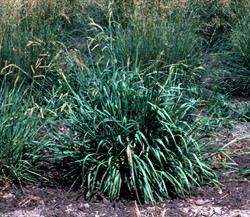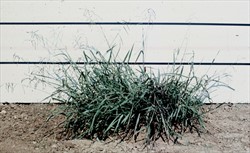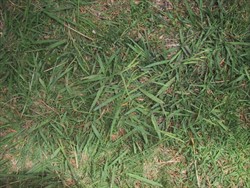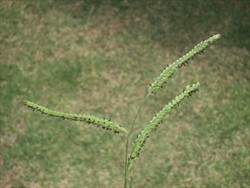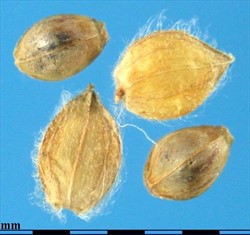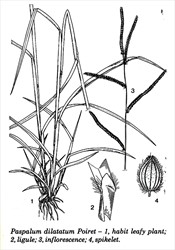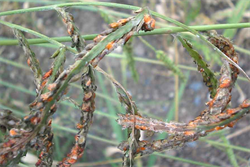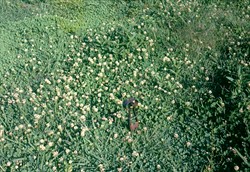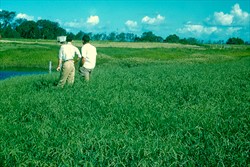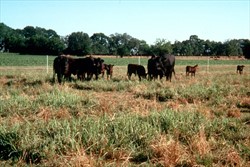Paspalum dilatatum
Tropical Forages
Paspalum dilatatum Poir.
Subordinate taxa:
Paspalum dilatatum Poir. subsp. dilatatum
Paspalum dilatatum Poir. subsp. flavescens Roseng., B.R.Arrill. & Izag.
None listed in GRIN.
Family: Poaceae (alt. Gramineae) subfamily: Panicoideae tribe: Paspaleae subtribe: Paspalinae group: Dilatata.
Leafy, tufted, sod-forming perennial, with clustered shoots arising from short rhizomes 4–8 mm diameter, bearing thick fibrous roots to >1 m deep. Foliage largely basal, (10–) 20–50 (–90) cm tall; leaf blades 3–13 (–20) mm wide, (6–) 12–25 (–45) cm long, largely glabrous except for a few long hairs near the collar; ligule membranous, bluntly triangular to 6 mm long; leaf sheaths glabrous (sometimes lower ones shortly pilose). Fertile culms ascending to erect, unbranched or rarely branched, 50–90 (–180) cm tall. Inflorescence a simple panicle comprising 2–5 (–11) widely separated, alternate racemes, the lowest 3–10 (–13) cm long, the upper ones shorter. Spikelets broadly ovate, green or purplish, 3–4 mm long, borne in pairs along one side of a flattened rachis, 2 mm long, reddish-brown, elliptic. 500,000–750,000 seeds per kg.
ssp. flavescens: tetraploids, yellow anthers, less common; inhabits only uplands.
ssp. dilatatum: mostly pentaploids, some hexaploids; inhabits periodically flooded lowlands and non-flooded uplands.
Similar species
P. dilatatum: leaf sheath largely glabrous; 2–5 (–11) racemes/panicle; spikelet 3–4 mm long; upper glume 5–9-nerved.
P. urvillei: more robust habit, dense, long radiating hairs on the lower leaf sheaths; spikelet 2–3mm long, upper glume 3–5-nerved; less palatable (also group Dilatata).
Asia: 毛花雀稗 mao hua que bai (China); rumput australi (Indonesia); シマスズメノヒエ shima-suzume-no-hie (Japan); lawa-lawa, halanaw, sakata (Philippines); ya-daenlit (Thailand); adi yalanci dari (Turkey); san dẹp (Vietnam)
English: bastard millet grass, caterpillar grass, dallis grass, golden crown grass, large waterseed paspalum, paspalum, water grass
Europe: hirse (Danish); paspale dilatée, herbe sirop, herbe de miel, herbe de dallis, millet bâtard (French); Dallisgras, brasilianische Futterhirse (German); paspalo dilatato (Italian)
Latin America: capim-comprimido; grama-comprida, capim-dallis, capim-melado, capim melador; capim-papua; grama-das-rocas; gramão; grama-samandura (Brazil); pasto dallis, zacate dallis, zacate dilación, zacate meloso, zacate miel (Mexico); caguazo, camalote, canara, cañota, chépica, grama alema, grama de agua, gramalote, grama sananduva, gramilla, gramilla blanca, gramilla de cuaresma, gramilla de hoja ancha, hierba dallis, hierba de australia, ninacuapé, pasto chato, paja melosa, pasto dallis, pasto dulce, pasto meloso, pasto miel, pasto polaco, pata de gallina (Spanish)
Indian Ocean: ahitsoavaly (Madagascar); herbe codaya, herbe à épée (Mauritius); herbe de miel, herbe sirop, gros chiendent (Réunion)
Pacific: hiku nua (Niue)
Southern Africa: bankrotkweek, breësaadgras, breësaadvleigras, gewone paspalum, paspalatum gras, watergrass (Afrikaans); mupunganini (Zambia, Zimbabwe)
subsp. dilatatum
Native:
South America: Argentina; Bolivia; Brazil; Chile; Paraguay; Uruguay
subsp. flavescens
Native:
South America: Argentina; Uruguay
Cultivated/naturalized:
Africa : Algeria; Angola; Azores; Canary Islands; Egypt; Ghana; Lesotho; Madeira Islands; Morocco; South Africa; Swaziland; Tanzania; Zambia
Asia: Armenia; Azerbaijan; China; Cyprus; Georgia; India; Indochina; Israel; Japan; Jordan; Philippines; Russian Federation-Ciscaucasia (Ciscaucasia); Sri Lanka; Taiwan; Turkey
Australasia & Pacific: American Samoa; Australia; Fiji; Hawaii; Johnston Atoll; New Caledonia; New Zealand; Niue; Solomon Islands
Europe: Croatia; France (incl. Corsica); Greece (incl. Crete); Italy (incl. Sardinia, Sicily); Portugal
Indian Ocean: Mauritius
Northern America: Mexico (Chiapas, Chihuahua, Jalisco, Mexico, Nuevo León, Veracruz); USA
Caribbean: West Indies
Central America: Costa Rica; El Salvador; Guatemala
Forage
One of the earliest tropical species adopted for permanent sown pastures. Also suitable for hay and silage, but should be cut before flowering to avoid hay being spoiled by presence of ergot-infected seedheads.
Environment
Once established, provides good stable ground cover to combat erosion, particularly that caused by water movement. Used to stabilize mine waste in South Africa.
Other
It has some value as a turf, but there are many stoloniferous species that provide a more manageable cover.
Soil requirements
Grows best on deep, moist, fertile, sandy loams and clays usually of alluvial or basaltic origin. Such soils are subject to compaction under intensive grazing. As the sward ages it often becomes sod-bound. Periodic renovation by ploughing, disc harrowing or deep ripping helps to overcome both conditions. If fertility is allowed to decline, P. dilatatum is gradually dominated by inferior species such as Axonopus fissifolius. P. dilatatum prefers a pH of 5.5–7, but will grow down to pH 4.5 and up to about 8. It has little tolerance of salinity, but is very tolerant of poor drainage.
Moisture
It is most prominent in areas with rainfall between 900 and 1,300 mm/yr, but also grows in lower areas with rainfall down to 750 mm, and extends at least to the lower slopes in higher rainfall (to about 1,700 mm) areas. It commonly invades irrigated pastures. The deep root system confers significant drought tolerance once it is established. It occurs in areas that are subject to flooding, tolerating inundation of up to one week.
Temperature
In its native environment, P. dilatatum occurs from sea level to 2,000 m and from about 20 to 35° S. It has become naturalized, in areas up to 2,300 m asl (Lesotho, 28º S) and beyond 40º N in Europe and USA. This is probably equivalent to an average annual temperature range of (10–) 15–20 (–23) ºC. Mean temperature of coldest month is 0–15 °C, and frost, sometimes snow, is encountered in parts of this distribution. Various optimum temperatures have been cited for development: 30 °C for leaf growth, 27 °C for tillering and 22.5 °C for flowering. Seed production is inhibited at temperatures below 13 °C. P. dilatatum is moderately frost tolerant (comparable with Cenchrus clandestinus and frost tolerant cultivars of Setaria sphacelata). While tops are killed by temperatures below -3 to -4 °C, plants survive lower extremes and regrow rapidly with the onset of warmer, moist conditions. Its post-winter regrowth is among the most rapid of the warm-season species.
Light
Grows in light shade, but is not as shade tolerant as Axonopus compressus or Paspalum notatum.
Reproductive development
It is a long day plant with a critical photoperiod 14–16 hours, although considered by some to be independent of day length. Flowering commences in early to mid summer, at which time vegetative growth slows markedly. Flowering continues through autumn, with little more foliage produced until the following spring.
Defoliation
Defoliation management largely needs to focus on suppression of inflorescence emergence. Seedhead development alone reduces leaf production, but the presence of ergot-infected seedheads poses a threat to animal health (see "Toxicity"). It is best, therefore, to maintain high grazing pressure during the flowering period in summer. Slashing or mulching may also be necessary to remove seedheads. The stand is most productive if maintained at 5–8 cm; lower grazing can reduce yields by up to two-thirds. P. dilatatum can tolerate heavy grazing, so sward density is unaffected.
Fire
Paspalum pastures are seldom subject to fire, but, if burnt, they quickly recover from the rootstock when conditions are again favourable.
Guidelines for establishment and management of sown forages.
Establishment
It can be sown at any time from spring to late summer, although best sown just before the expected rainy season since germination and establishment can be slow. There is some post-harvest dormancy. While seed is generally drilled or broadcast into a well-prepared, fine, weed-free seedbed, it can also be sown directly into rice stubble without further seedbed preparation. It is normally sown at 5–10 kg/ha, and preferably placed less than 1.5 cm deep.
Fertilizer
P. dilatatum can persist in a weak, unproductive state on infertile soils, but is usually dominated by inferior species such as Axonopus fissifolius in these situations. The trend towards Axonopus dominance can be easily reversed with the application of 100–150 kg/ha of fertilizer nitrogen. The use of strategic applications of nitrogen to paspalum can thus play an important role in extending the grazing season of this grass. Levels of other nutrients, particularly phosphorus, should be monitored and maintained.
Compatibility (with other species)
Although P. dilatatum is not overly competitive in its own right, the only legumes that are compatible with it are those that can tolerate the same grazing regime. Because of its slow establishment, other more rapidly establishing, but possibly shorter-lived grasses such as Chloris gayana and Setaria sphacelata are sometimes sown with it. Cool season legumes can be established into it by oversowing or sod-seeding during winter dormancy.
Companion species
Grasses: Acroceras macrum, Axonopus fissifolius, Chloris gayana, Setaria sphacelata.
Legumes: Arachis pintoi, Lotus uliginosus, Trifolium repens, T. semipilosum, Vigna parkeri.
Pests and diseases
The main disease is ergot, caused by the fungus, Claviceps paspali. The disease first appears in the form of a dark, sticky exudate from the spikelets or "seed". A sclerotium replaces the caryopsis, and secondary fungi grow on the exudate. Anthracnose (Colletotrichum graminicola) and leaf blight (Helminthosporium micropus) also attack the plant but have little effect; similarly the paspalum striate mosaic virus transmitted by a leafhopper (Nesoclutha pallida (obscura) Cicadellidae).
Roots are attacked by the larvae of a number of scarab beetles, caudata canegrub (Lepidiota caudata), white grub (Rhopaea paspali), and the african black beetle (Heteronychus arator) which reduce pasture productivity and open swards. Argentine stem weevil (Listronotus bonariensis Coleoptera: Curculionidae) is also recorded as a pest, but damages softer species more severely. The sugarcane borer (Diatraea saccharalis Lepidoptera: Pyralidae) sometimes attacks it.
Ability to spread
It spreads readily by seed where conditions are suitable for germination. Vegetative spread is extremely slow. Although a slow establisher and with the impediment of disease of the inflorescence, it has been a remarkably successful coloniser.
Weed potential
It is considered a serious weed of fine turf and a weed of some concern in crops. Regulated as a pest in Canada under the Plant Protection Act, and listed as a prohibited noxious weed.
Nutritive value
It declines markedly in feeding value as it matures. Digestibility ranges from 57 to 63% and CP from 4 to 23% depending on age of regrowth and nitrogen fertility of the soil.
Palatability/acceptability
In the pre-flowering stage, it is very palatable. Mature growth, particularly when associated with ergot-infected inflorescences, is less attractive to stock.
Toxicity
The grass itself is not known to be toxic, but seedheads parasitised by the ergot fungus, Claviceps paspali, whether in pasture or in hay, can be toxic due to production of tremorgenic pyridine alkaloids in the sclerotia, which appear in late summer or autumn. The yellow-grey sclerotia are round, roughened, and 2–4 mm in diameter. Various alkaloids are identified in the literature as being isolated from C. paspali sclerotia, although not all may have clinical effect: agroclavine, chanoclavine, elymoclavine ergine, ergovaline, ergonovine, isoergine, lysergic acid N-1-hydroxyethylamide, paspaline, paspalicine, paspalinine, paspalitrem A and B, and two unidentified ergoline alkaloids. Rations containing >0.6% of ergot are potentially toxic. Affected animals (all classes of livestock) at first show excitement, distrust of people and a tendency to attack. Later they tremble, appear to lack muscular control, stagger and may fall. They recover in a few days if removed from infected areas in the early stages of excitement. Topping of the pasture to remove affected seed heads has been effective in control.
Feedipedia link
Dry matter
Total productivity varies with genotype, and growing conditions, including temperature, soil fertility, moisture etc., and pattern of production relates to flowering time. P. dilatatum is one of the most productive of the warm season grasses in the early spring, but productivity declines with the onset of flowering. Annual yields of 15 t/ha DM have been achieved, but can be as low as 3 t/ha. Well-fertilized grass can produce 50–60 kg/ha/day DM when growing actively.
Animal production
Can support 25 sheep per hectare during the growing season. At 34º S, an irrigated, fertilized system, with P. dilatatum constituting 70% of the feed in spring and summer, and sod-seeded temperate species providing the bulk of feed in the cool season, can consistently produce more than 10,000 litres of milk per hectare per year (Friesian cows at 2.5 per hectare in winter, and 5 per hectare in spring and summer).
Various polyploid biotypes, including:
- apomictic tetraploids (2n = 4x = 40), subsp. pauciciliatum [ now considered a separate species, Paspalum pauciciliatum (Parodi) Herter].
- sexual tetraploids (2n = 4x = 40) include subsp. flavescens, and 'Virasoro' and 'Vacaría' biotypes. The group comprises both yellow- and purple-anthered type; genomic formula, IIJJ.
- apomictic allopentaploids (2n = 5x = 50) or 'Common' type; considered to have originated from a hybridization event between a var. flavescens type and a hexaploid biotype such as 'Uruguayan'; has purple anthers; irregular meiosis, with genomic formula, IIJJX (I and J genomes homologous to those of diploid P. intermedium and P. juergensii, respectively, but the source of the X genome is unknown); reproduces by apospory and pseudogamy ; little variation among the various phenotypes.
- apomictic allohexaploids (2n = 6x = 60), e.g. 'Uruguaiana', 'Uruguayan' and 'Torres' biotypes.
- septaploid (2n = 7x = 70), a recent discovery at Villa Serrana, Lavalleja, Uruguay.
Breeding is focussing on the use of the possible diploid progenitors, P. intermedium, P. juergensii, P. paniculatum, and P. urvillei to improve ergot resistance.
P. dilatatum seeds freely, but the seed ripens from the tip of the racemes downwards and shatters as soon as it is ripe. It is thus hard to harvest, and viability is often low. Seed production is also affected by ergot infection. Crop management is similar to that for P. notatum, i.e. graze the paddock heavily (to c. 7 cm) during spring following a dressing of 50‒75 kg/ha N (preferably as a mixed fertilizer), and follow up with a further 50‒75 kg/ha N in the boot stage in early summer. Seed ripens progressively over the summer and at no time is all the seed mature. Because of the asynchronous ripening of seed, one approach with harvesting is to use a mechanical stripper or brush harvester, which non-destructively removes only ripe seed, facilitating up to 10 passes with the machine in a season. This can yield 30 kg or more of seed each pass. Header harvesting should begin when 60‒80% of the seed-heads are of a light brown colour. Crops are often mixed with Axonopus fissifolius, the seed of which is easily screened from the P. dilatatum seed. Ergot sclerotia are mostly larger than the seed and can also be largely removed with screening.
Triclopyr and picloram, halosulfuron-methyl, imazethapyr and 2-4, D can be used for broadleaf weed control in grass swards. Young plants of P. dilatatum can be controlled with paraquat, while older stands are best controlled with glyphosate, preferably pre- or early flowering. Stands can be desiccated with fluazifop-P, glufosinate, and haloxyfop. Pre-emergent herbicides that can be used to control germinating seed include bensulide, DCPA, dithiopyr napropamide, oryzalin, oxadiazon, pendimethalin, prodiamine, pendimethalin, oryzalin, or combinations of benefin plus oryzalin, or benefin plus trifluralin.
- High palatability when young.
- Ability to stand heavy grazing and tramplin.g
- Legume compatibility.
- Tolerant of waterlogging.
- Short grazing season.
- Early and heavy seeding.
- Susceptibility to ergot.
- Tendency to become sod-bound.
Acuña, C.A., Martínez, E.J., Zilli, A.L., Brugnoli, E.A., Espinoza, F., Marcón, .F, Urbani, M.H. and Quarin, C.L. (2019) Reproductive systems in Paspalum: Relevance for germplasm collection and conservation, breeding techniques, and adoption of released cultivars. Frontiers in Plant Science. 10: 1377. https://doi.org/10.3389/fpls.2019.01377
Bogdan, A.V. (1977) Tropical Pasture and Fodder Plants. Longman Inc., New York, USA. p. 205–212.
Burson, B.L. and Watson, V.H. (1995) Bahiagrass, dallisgrass and other Paspalum species. In: Barnes, R.F, Miller, D.A. and Nelson, C.J. (eds) Forages, Vol. I: An introduction to grassland agriculture. Iowa State University Press, Ames, IA, USA. p. 431–440.
Burson, B.L., Voigt, P.W. and Evers, G.W. (1991) Cytology, reproductive behavior, and forage potential of hexaploid dallisgrass biotypes. Crop Science 31:636–641. doi.org/10.2135/cropsci1991.0011183X003100030018x
Casa, A.M., Mitchell, S.E., Lopes, C.R. and Valls, J.F.M. (2002) RAPD analysis reveals genetic variability among sexual and apomictic Paspalum dilatatum Poiret biotypes. Journal of Heredity 93:300–302. doi.org/10.1093/jhered/93.4.300
Evers, G.W. and Burson, B.L. (2004) Dallisgrass and other Paspalum species. In: Moser, L.E., Burson, B.L. and Sollenberger, L.E. (eds) Warm-Season (C4) Grasses. Agronomy Monograph No. 45. ASA, CSSA, SSSA, Madison, WI, USA. p. 681–713. doi.org/10.2134/agronmonogr45.c20
Hacker, J.B., Williams, R.J., Vieritz, A.M., Cook, B.G. and Pengelly, B.C. (1999) An evaluation of a collection of Paspalum species as pasture plants for southeast Queensland. Genetic Resources Communication No. 32. CSIRO Tropical Agriculture, St Lucia, Australia. bit.ly/3dLHRkq
Mannetje, L.’t and Kersten, S.M.M. (1992) Paspalum dilatatum Poiret. In: Mannetje, L.’t and Jones, R.M. (eds) Plant Resources of South-East Asia No. 4. Forages. Pudoc Scientific Publishers, Wageningen, the Netherlands. p. 178–180. edepot.wur.nl/327785
Venuto, C., Burson, B.L., Hussey, M.A., Redfearn, D.D., Wyatt, W.E. and Brown, L.P. (2003) Forage yield, nutritive value, and grazing tolerance of dallisgrass biotypes. Crop Science 43:295–301. doi.org/10.2135/cropsci2003.2950
'La Estanzulea Chiru' or 'Chiru' Released in Uruguay. Selection from 'Uruguayan' biotype. More erect than 'Common' and produces more forage. Not widely used.
'Grasslands Raki' Released in New Zealand (1979) .Composite of two accessions selected on the basis of productivity from 22 accessions from Uruguay. At least as productive as best commercial lines available in NZ. Susceptible to ergot.
'Louisiana B-230' Released in USA (1951). Selected from clones from naturalized stands in southern USA for seed yield and quality as well as forage traits. Better quality seed and remaining green later in autumn than 'Common'.
'Louisiana 430' Released in USA (1951). Selected from clones from naturalized stands in southern USA for seed yield and quality as well as forage traits. A higher pure live seed content and less ergot (Claviceps paspali) infection than naturalized 'Common'.
'Natsugumo' Released in Kumamoto, Kyushu, Japan (1980). Selected from naturalized dallisgrass plants from southern Kyushu. Taller, with longer, narrower leaves than 'Louisiana B-230'. Flowers later and produces more dry matter than 'B-230'.
Biotypes
'Common' Native to western Uruguay. Semi-erect to erect growth habit, with erect or nodding panicle comprising (2‒) 3‒5 (‒11), ascending to drooping racemes, 3‒10 cm long. The type most commonly planted and naturalized throughout the subtropics and temperate areas. More cold tolerance than the 'Uruguaiana' and 'Torres' biotypes, but less than that of 'Uruguayan'.
'Torres' Native to north-eastern Rio Grande do Sul to south-eastern Santa Catarina, Brazil. Semi-prostrate growth habit, with multiple racemes arranged in a spiral, somewhat similar to those of 'Uruguayan'. Its spikelets are glabrous and smaller than those of common. Lacks the persistence to be potential forage.
'Uruguaiana' Native to western Rio Grande do Sul, Brazil. More robust than 'Common'. Inflorescences normally with more racemes arranged in a spiral on the central axis; spikelets similar to those of common. Lacks the persistence to be potential forage.
'Uruguayan' Native to north-western and northern central Uruguay. More robust, and grows more erect than 'Common'. Inflorescences normally with more racemes arranged in a spiral on the central axis; spikelets similar to those of 'Common'. More cold tolerant than 'Uruguaiana' and 'Torres' biotypes. Persists better and produces more forage on poorly drained clay soils than 'Common'. Nutritive value equivalent to that of 'Common'. Could have commercial value.
'Vacaria' Native to north-eastern Rio Grande do Sul to south-eastern Santa Catarina, Brazil. Variable comprising an array of types intermediate between subsp. flavescens and P. urvillei.
'Virasoro' Native to north-eastern Corrientes Province, Argentina to northern central Rio Grande do Sul, Brazil. Morphologically similar to subsp. flavescens (including anther colour), but has more racemes (8‒12) that tend to ascend or droop downward. Has some resistance to Claviceps paspali.
subsp. flavescens Native to southern Uruguay, eastern Buenos Aires Province, Argentina. Yellow-anthered dallisgrass. More upright growth habit than 'Common', with larger, more pubescent spikelets.
P. pauciciliatum Native to eastern Argentina, southern Brazil, Paraguay, Uruguay. Prostrate dallisgrass. More decumbent growth habit, and spikelets slightly smaller and less pubescent than those of 'Common'. Stand persistence and forage production satisfactory, but major limitation is poor seed set.
None reported.
